We’ve all heard the saying that goats will eat anything. Only, it simply isn’t true. You won’t actually see a billy goat eating a tin can, it’s just a myth.
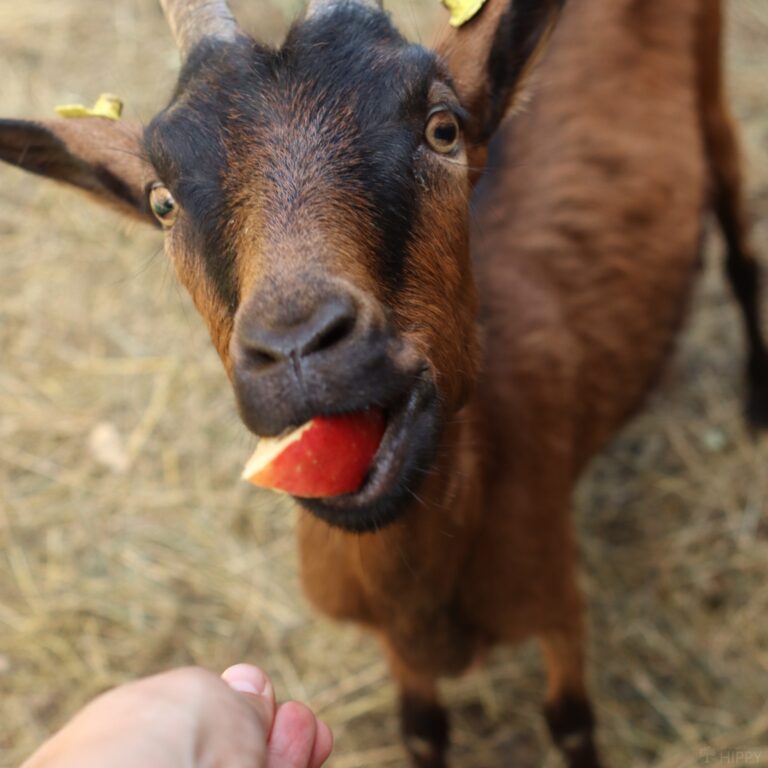
Goats don’t really eat those things. In reality, goats can be surprisingly picky eaters, which generally helps protect them from eating anything poisonous or dangerous.
Although goats often use their mouths to explore your clothes, hair, and random items they come in contact with, they aren’t likely to eat things that aren’t actually edible.
Their lips and tongues are very sensitive and help them explore, much like a baby that puts things in his or her mouth. So most likely, when you see goats eating strange things, they’re really just checking them out and not eating them at all.
That being said, goats can get into a bit of trouble when it comes to things such as grain or chicken food, which they seem to just love. If they overeat some of these things, they can become very sick.
So what do goats eat? You might be surprised to learn what goats should eat, what they love to eat, and how many different ways you can feed them.
Table of Contents
Goat Digestion
Goats are classified as ruminants, which is an animal that has four stomachs. As they eat, their stomachs ferment the food to help them digest it and get more out of it as it passes through all four stomachs.
It’s no wonder goats burp and pass gas with all that fermentation going on in their stomachs.
This also makes them subject to bloat, a dangerous illness that strikes fast and can be deadly. Bloat can be caused by too much of certain foods or even by sudden changes in diet.
If you are going to change what your goats eat, its best to make the change slowly, so as not to give them bloat or scours (goat diarrhea). So with all of these things to consider, what should you fill up those little goat bellies with?
Browsing for Food
Goats are like deer, in that they prefer to eat food that is considered browse, rather than food that is considered pasture. Pasture is just what you think – land that is covered with grass and low-growing plants.
Generally, sheep and cows will graze on pasture, with their heads down. A goat might eat pasture if it has nothing else, but if pasture is the main source of food for a goat, they are more likely to suffer from parasites.
You’re probably better off leaving your pasture to the cows and feeding some other good stuff to your goats.
Browse is the ‘stuff’ that grows a bit higher up. Think of shrubs, low branches of trees, tall weeds, and other vegetation that they have to reach up just a little bit to eat.
This is why goats are often brought in to clear abandoned or unused land. It isn’t just full of grass and weeds, but it likely has small trees, shrubs, and other vegetation that goats love to eat.
Goats seem to love the variety that browse offers them. And even if they come across a noxious or toxic plant in their browse, they aren’t likely to eat enough of it to be bothered by it because they are eating so many other things along side of it.
One of my goats, a large Lamancha named Jebediah, would escape his enclosure routinely so he could get to the browse that surrounded the edges of my property.
Rather than indulge in free choice hay, which was readily available to him and the other goats, he preferred to munch on apple trees, walnut leaves, honeysuckle bushes, poison ivy, and a pile of unknown weeds that grow along the lane.
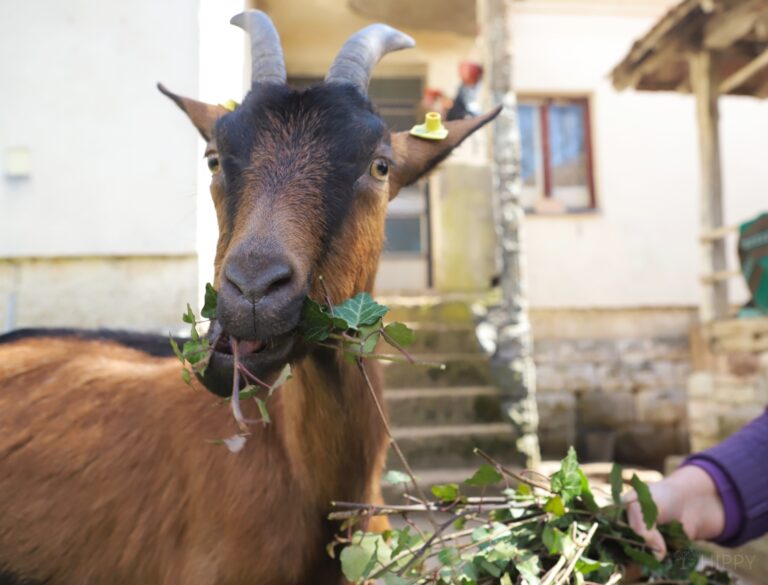
Then he would routinely hop into the garden, where he obliviated the blackberries and rolled on the mint. After that, he wandered his way to the front porch, where he de-blossomed the roses and parked himself on the porch.
Maybe the grass wasn’t greener on the other side, but the tasty browse and delicacies were just too tempting to contain him in his pen.
It didn’t matter how tall the fence was, he was determined to get to the good stuff: the browse. But if you don’t have unlimited access to browse for your goats, what can you feed them?
Hay
Hay is a staple for goats. They’ll eat about three to four percent of their body weight in hay per day, which is roughly two to four pounds, depending on the size of your goat.
If they have browse to eat, or a pasture to nibble on, they’ll likely eat less hay.
Generally, I put a couple flakes out for my two pet goats in the morning and a couple more in the evening, but if bad weather is coming and I’ll know they’ll prefer to be holed up in their shed, I’ll put a full bale inside for them to enjoy.
There are all sorts of kinds of hay that you can feed to your goats. If you’re used to feeding horses, you’ll be used to feeding very high-quality hay, which can be very expensive.
Goats, however, can handle a little less quality high, so long as it is still good and has plenty of nutritional value. For example, horse hay needs to be pretty pure so it doesn’t upset a horses digestive system.
But goats can handle a few weeds in their hay, especially considering they love to eat weeds when they browse.
It isn’t unusual where I live to find a few horse farmers selling off lower-quality horse hay to goat farmers. It’s a great way to get a little hay at a lower price. Which hay should you choose? Well, it really depends on your location, your growing season, and your goats.
An ideal sort of hay is a mix of alfalfa and grass hay, which gives a variety of nutrients, including protein. Alfalfa hay is great for your goats as they are high in protein.
- ✅Timothy Hay. In Pennsylvania, we have easy access to timothy hay. It seems to grow in spite of our cold winters, so that’s what we feed our goats as a staple. It is readily available, suitable for the climate, and not terribly expensive.
- ✅Alfalfa Hay. Alfalfa hay is grown in the northern and western parts of the United States. It can be grown in more southern states but is more susceptible to the humidity and diseases. Alfalfa hay has a higher content of protein, vitamins, and minerals than most grass hays. This makes it ideal for lactating does, pregnant does, and for goats that need a nutritional boost.
- ✅Alfalfa Mix. Alfalfa mixed with grass hay is an ideal mix. This way, it doesn’t give the goats too much protein and offers a wide variety of nutrients, especially zinc.
- ✅Fescue. Fescue is grown more towards the Midwest and southeastern portions of the United States. There is some concern about fescue causing toxicity or parasites in goats, you’ll have to use good parasite control and additional supplements if you feed fescue to your goats.
- ✅Bermuda Grass. Many goats can do well on Bermuda grass, which is grown more in the sandy soils of the southeast. It is critical to find the right cultivar of Bermuda grass, since not all varieties are winter hardy and some are less than palatable to goats.
- ✅Orchard grass. The all-star hay for goats is second cutting orchard grass. It is grown all of the United States but seems particularly well-suited for the East Coast. Orchard grass is a good source of protein for goats, and they like it!
- ✅Ryegrass. Ryegrass is a good source of nutrition for goats. It makes a great choice for winter, especially when mixed with clover.
You can feed goats twice a day or put your hay out for them free choice. They will probably quickly learn to associate you with food and come running every time they see you.
And although a bale of hay does not cost that much, goats seem to think they should waste a lot! Any hay that falls to the ground will likely be snubbed by your goats.
If it gets wet, trampled on, sat on, or even barely disturbed, they probably will turn up their cute little noses in disdain. Goats are far pickier eaters than most people know! You can reduce the amount of wasted hay by serving it up in a specialized hay feeder, such as a hay feed bag that hangs inside your goat barn.
Because we had such a wet spring, the cost of hay went up, however it is still an affordable means of feeding goats that don’t have enough browse.
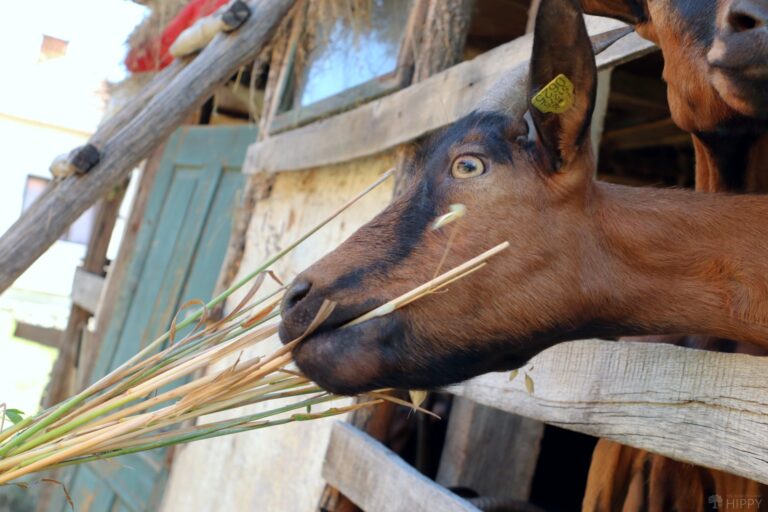
Straw. Don’t confuse hay with straw. Straw makes great bedding but terrible feed. Straw is the leftover stalk from grains such as wheat. After the wheat is harvested, the waste is bound up into bales.
There is little to no nutritional content in straw, so don’t feed it to your goats. However, it is highly absorbent and a natural insulator, so it makes great bedding, especially in the heat of summer and the cold of winter.
Things Goats Can Safely Eat
Some of the veggies you may have on your homestead that your goats can eat include:
- ✅cabbage
- ✅apples
- ✅bananas
- ✅pineapples
- ✅grapes
- ✅carrots
- ✅cucumbers
- ✅raisins
- ✅acorns
- ✅celery
- ✅garlic
- ✅mint
- ✅pea pods
- ✅squash
- ✅peppers
- ✅straw
- ✅sunflower
- ✅weeds
- ✅arugula
- ✅minerals
- ✅roses
- ✅baking soda
- ✅peaches (no pits)
- ✅plums (no pits)
- ✅strawberries
- ✅raspberries
- ✅broccoli
- ✅oranges
- ✅poison oak
- ✅maple leaves
- ✅peppers
- ✅pumpkins
- ✅pea pods
- ✅fescue
- ✅grapefruit
- ✅blueberries
- ✅mango
- ✅whole grains
- ✅rolled grains
- ✅Ivy
- ✅pelleted grains
- ✅rice
- ✅lemons, oranges, and other citrus fruits
- ✅thorns
- ✅lettuce
- ✅asparagus
- ✅bread
- ✅pine needles
- ✅popcorn
- ✅peanut butter
- ✅nuts
- ✅kiwi
- ✅mushroom
- ✅spinach
Alternatives to Hay
✅Chaffhaye. Chaffhaye is like forage in a bag. It is chopped and bagged alfalfa that has been allowed to ferment, providing beneficial bacteria for your goats. It is often mixed with molasses for even more nutrition.
A goat should be fed two to two and a half pounds of chaffhaye for every hundred pounds it weighs. Although a bag of chaffhaye is more expensive than a bale of alfala hay, it has more nutritional quality and will last longer.
✅Alfalfa pellets. Alfalfa pellets are basically made up of alfalfa hay that has been ground up and put into pelleted form. This reduces waste and is easy to feed.
However, goats will still need some of the leaves and woody stems to aid in their digestion, so although alfalfa pellets are a great way to feed goats, you will need to supplement their feed with some other items.
✅Grains. While it is fine to feed hay free choice to your goats, grains are a different story. Goats seem to just love grains and they go hog-wild when presented with grains.
But too much of a good thing – or at least too many grains – can make your goat very sick. So if you want to feed grains to your goats, go ahead, but limit the amount that each animal can eat to about a cup per adult goat, and half a cup per goat kid.
There is no need to feed grains to your goats, they can do just fine on hay. On the other hand, hay can be a good source of nutrition to lactating does, and good motivation to stay on the milking stand if that’s where they are fed their grains. There are four types of grains available for goats:
- ✅Whole grains. Whole grains are unprocessed, like corn.
- ✅Pelleted grains. Pelleted grains are grains that have been ground up at a mill and compressed into pellets. It may be mixed with binders and medication.
- ✅Rolled grains. This would be something like oats.
- ✅Texturized grains. Texturized grains are a mix of oats and other grains for additional nutritional value.
- ✅Sweet Feed. Sweet feed is generally a mix of grains or pelleted grains and molasses and typically has little nutritional value.
Goats adore sweet feed and if they are fed too much, become junk food junkies! You don’t need to give your goats sweet feed, but it is a fun treat.
And because they love it so much, it can be a great training tool to teach your goats to do what you want. It is fine to give them some sweet feed, just remember that it is a treat and not a staple, so limit the amount of sweet feed you give them.
✅Weeds and yard clippings. A great way to supplement the way you feed your goats is to toss them some weeds.
Whenever I pull weeds in the garden, trim trees, or chop down some shrubs, I toss the waste into the goat pen. If they like it, they eat it! If not, they just leave it alone.
After Christmas, you can toss your live tree to the goats so long as it hasn’t been treated with pesticides or preservatives and make sure any decorations or wires are completely removed. My goats enjoyed playing with and munching on our old Christmas tree for a few weeks.
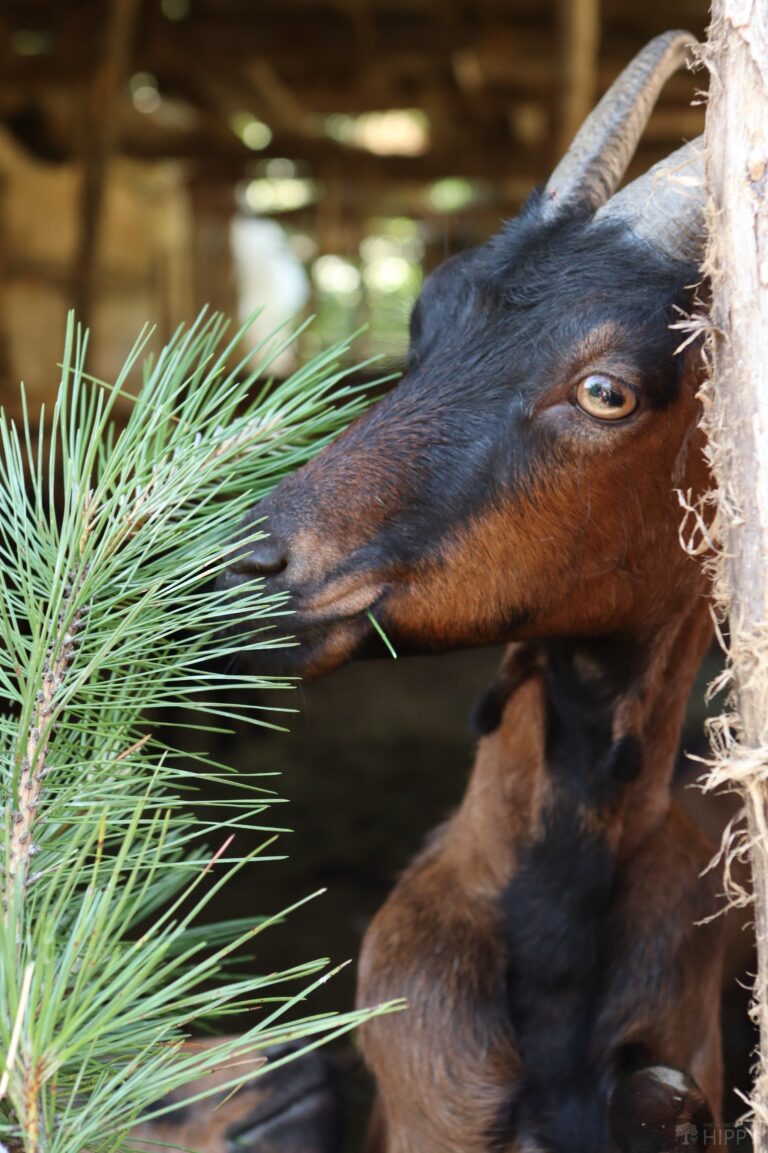
Kitchen scraps. You can feed goats certain kinds of kitchen scraps, in moderation. For example, banana peels, celery, apples, carrots, carrot tops, and even citrus peels are edible.
They may also enjoy nibbling on raisins, tomatoes, sunflower seeds, and corn husks. My children are notorious for taking a bite out of an apple and forgetting to eat the rest – this makes a great treat for a goat.
✅Minerals. Goats can easily suffer from mineral deficiencies. This is easily remedied by feeding free choice loose minerals. Mineral blocks are not suitable to goats, so make sure to feed them plenty of loose minerals for overall health.
✅Baking soda. Goats are often subject to bloat. Free choice baking soda will help keep a goat’s rumen pH balanced and will aid in digestion. It may help prevent them from getting bloat, as well.
You don’t need to worry how much baking soda your goat eats; they seem to be able to eat just the right amount that they need. Offer it free choice alongside of your goat minerals.
✅Water. Typical goats need as much as two to three gallons of water per day, and even more when the weather is hot. Lactating does may also need more water.
When goats are eating lots of fresh grass, they may drink less as they are getting moisture content from the grass. In winter, goats really appreciate drinking their water hot! When possible, offer them a bucket of hot water on cold mornings and see how they do.
What Do Baby Goats Eat?
Baby goats eat the same things that adult goats eat, by and large, but they don’t start out eating those foods.
Compared to adults, baby goats, or kids, have a very limited and specific diet consisting mostly of milk. But once they reach about 8 weeks of age, they are ready to start eating a diet consisting predominantly of solid, varied foods going forward.
During the earliest phases of their life, kids eat the following:
- Milk: critically important for the health and well-being of baby goats, milk is a mainstay and will make up the vast majority of their calories and calcium intake during the first week of life and much of the next 2 or 3. Baby goats can nurse from their mother or another lactating surrogate doe, be bottle-fed milk that you take from a lactating goat, or fed milk replacer that is commercially available and mixable.
- Colustrum: colostrum, sometimes called early milk, is a nutrient- and hormone-rich solution that is essential for stabilizing and jump starting a baby goat that is newborn. Any newborn kid should have colostrum within 1 hour of birth, and if for whatever reason it cannot feed from its mother you must supply the colostrum one way or another, either by milking the mother or by using a colostrum replacer in the same way that you would use a milk replacer.
- Hay: after kids are about a week old, they will start to take occasional, exploratory nibbles of hay, known as creep feeding. Hay is extremely important for goats and is a staple of their diet, and week over week they will eat more and more hay until it becomes their primary food.
- Grains: goats don’t need much in the way of grains, and neither do baby goats, but grains still contain essential nutrients and plenty of calories that can benefit them. Often supplied to baby goats in the form of starter feed and later typical goat pellets, they are easy to digest compared to whole grains, and make your job of moderating their diet much easier.
- Pasture: goats are browsers, not grazers, and baby goats that are entering adolescence will start to pick and choose as adult goats do. They enjoy eating grass and various choice bits of plants from the pasture, including clover, leaves, flowers, various types of ivy and kudzu, thistle, and more.
- Weeds and Other Foods: a small but still significant part of a baby goat’s diet consists of berries, pine needles, and similar plant matter and, of course, a great variety of weeds. Dandelions, horseweed, and burdock are among the most nutritious and popular of the latter.
Newborns Drink Mostly Milk and Eat Just a Little Food
It is essential that newborn goats- those that are less than a week old- subsist almost entirely on milk. Their digestive system is not developed enough to handle solid foods. Outside of the most incidental bites or nibbles of grass or hay, milk and before that colostrum are the only things that they should be consuming.
This applies even to bottle babies, newborn goats that for whatever reason cannot drink and bond to their mother. You’ll have to keep your bottle-fed kid on a strict schedule of feedings and ideally collaborate with an agricultural veterinarian so they can advise you on what vitamins and minerals should be added to the formula according to the needs of the little one.
Baby Goats Should Be Fed 10%-12% of Their Body Weight Daily
The rule of thumb for newborn goats is they should be eating anywhere from 10% to 12% of their body weight daily, and either actual goat milk or milk replacer. This is the only way to ensure that they stay healthy and grow optimally. Reduced calories and insufficient nutrients can have devastating health consequences for rapidly growing kids.
At 8 Weeks, Baby Goats Eat a Normal Diet
Week over week, a baby goat will naturally start drinking less milk and eating proportionally more solid food from the list above. At around 8 weeks of age, or a little bit older, they should be weaned off of milk entirely and eating the same diet, more or less, as any other goat in the herd.
It is okay to introduce new foods to a kid as they grow, but you always want to do it very slowly and in very small quantities so that their digestive tract has time to adjust. Excessive quantities or bombarding them with too much novel food, too quickly, can lead to gas bloating, diarrhea and other problems.
Once the kid has reached 8 weeks of age, their dietary intake should more or less conform to the following guidelines, to be modified as they mature according to your objectives and their health:
Hay: 80% of calorie intake. Hay is a staple for goats, and necessary for their digestive system to function properly.
Feed: 5% of calorie intake. Goat feed typically contains grain, and young goats don’t need too much of that in their diet or else it can cause problems like bloating.
Pasture and weeds: 15% of calorie intake. Whether it is grass, weeds or other choice bits of their favorite plants, this is still an important component of their diet despite them subsisting mainly on hay.
Baby Goats Must Never Eat Toxic Foods!
As you might expect, baby goats are even more vulnerable to harmful foods than adult goats owing to their lower body weight and underdeveloped systems. Toxic foods or worse, ones that are outright poisonous, can easily kill a precious little kid.
Ensure that they never eat anything that they shouldn’t have. See the list of designated harmful foods in the next section!
What Shouldn’t Goats Eat?
Goats are generally pretty smart about what to eat and not eat, aside from grains, that is. However, a goat that does not receive adequate nutrition may resort to eating vegetation that is toxic, although this is generally rare.
While goats generally avoid toxic plants, you should be careful not to feed them yew, red maples, or rhododendrons, as well as these:
- ❌avocado
- ❌oleander
- ❌lilacs
- ❌Rhubarb leaves
- ❌nightshade
- ❌choke cherries and choke cherry leaves
- ❌ yew
- ❌rhododendron
- ❌red maples
- ❌larkspur
- ❌varebells
- ❌meat
- ❌delphinium
- ❌Indian hemp
- ❌bloodroot
- ❌gourds
- ❌dogbane
- ❌dog food
- ❌buckwheat
- ❌foxglove
- ❌eggplant
- ❌water hemlock
- ❌Indian poke
- ❌kale
- ❌soapwort
- ❌clover
- ❌chocolate
- ❌chicken feed
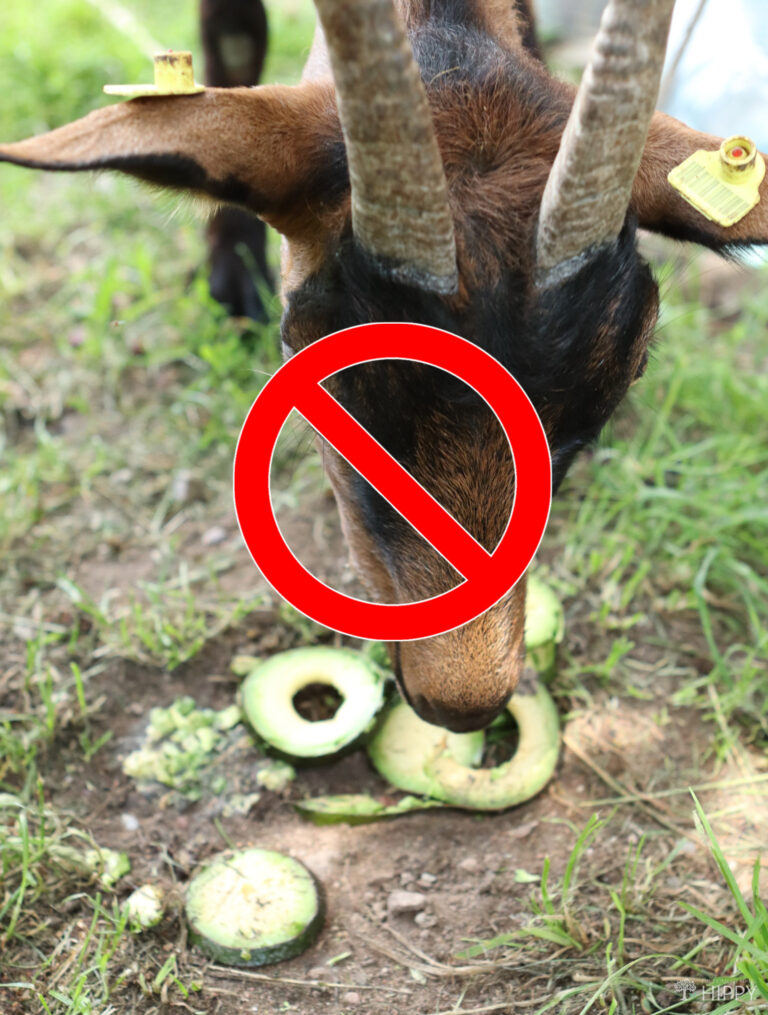
Deciding what to feed your goats is going to be a mix of personal preference, economics, herd size, and availability.
You may need to feed your goats extra grains if you are stuck in a drought, you may need to feed a variety of hay over the course of the winter, or you might be able to feed your goats solely on the browse where you live.
If you have a large herd, you may have to feed them based on what types of hay or grains are available in your area or what you can grow in your own pastures.
Pregnant and lactating does will need extra nutrition, especially if you plan on drinking the milk they produce.
On the other hand, while you want your pet goats to be healthy, if you aren’t going to consume their meat or their milk, you may not need to worry as much about making sure their diet is perfectly healthy all of the time, and you may feel like spoiling them with a few extra treats.
When I had a herd of milk goats and baby goats, I carefully fed them the most healthy and balanced diet that I could because I knew we would be consuming their milk.
When I had a very determined escape goat, I didn’t worry much about how much hay he ate since he was always munching on something around my yard, such as my roses, bushes, and vegetables.
At the moment, my heard consists of a couple of extremely spoiled pet wethers. And while I want them to be as healthy as possible, my children and I get a kick out of spoiling them and seeing what they will and won’t eat.
Since they share a pen with the chickens, they sometimes get a hold of the scraps meant for the chickens, making for a hilarious and entertaining feeding frenzy.
Some crazy things my goats eat… So far, my pet goats will snub their noises at zucchini and squash and they disdain any hay that has fallen on the ground or that stays in the feeder for more than a day.
They have certainly indulged in some crazy treats that might not be too healthy or appropriate, but at least are fed only in small amounts.
I don’t recommend all of these foods for you to feed your your goats, it’s up to you to decide the best way to feed and care for your ruminents.
Through trial and error, I’ve discovered that stale Fruit Loops that my children have forgotten in the cupboard are a treasure trove of treats for the goats.
Since Fruit Loops are pretty much grains and sugar, it’s an ok treat! They’ve devoured leftover pancakes, animal crackers, and stale cookies, too. An occasional Dorito or slice of bread is a delight for a goat.
They’ve been known to surprisingly scarf up a hotdog or two (and a few other items meant to go to the chickens), a bite of cupcake, and all kinds of leftover fruits and vegetables, especially bananas that are too far gone for human consumption.
And while I don’t make it a habit, I’ve never seen anything funnier than a cute little goat downing a great big slice of cheese pizza.
Wrap-Up and Your PDF Printable Checklist
Of course, these human foods aren’t the most ideal feed for goats, and you should think twice before trying it at your farm, but when your goats are well fed on quality hay, an occasional treat goes a long way to win over those stubborn and delightful personalities.

Now, before you go, you may want to print out this PDF checklist of things that goats can and cannot eat.
And don’t forget to pin this article on your favorite Pinterest board!
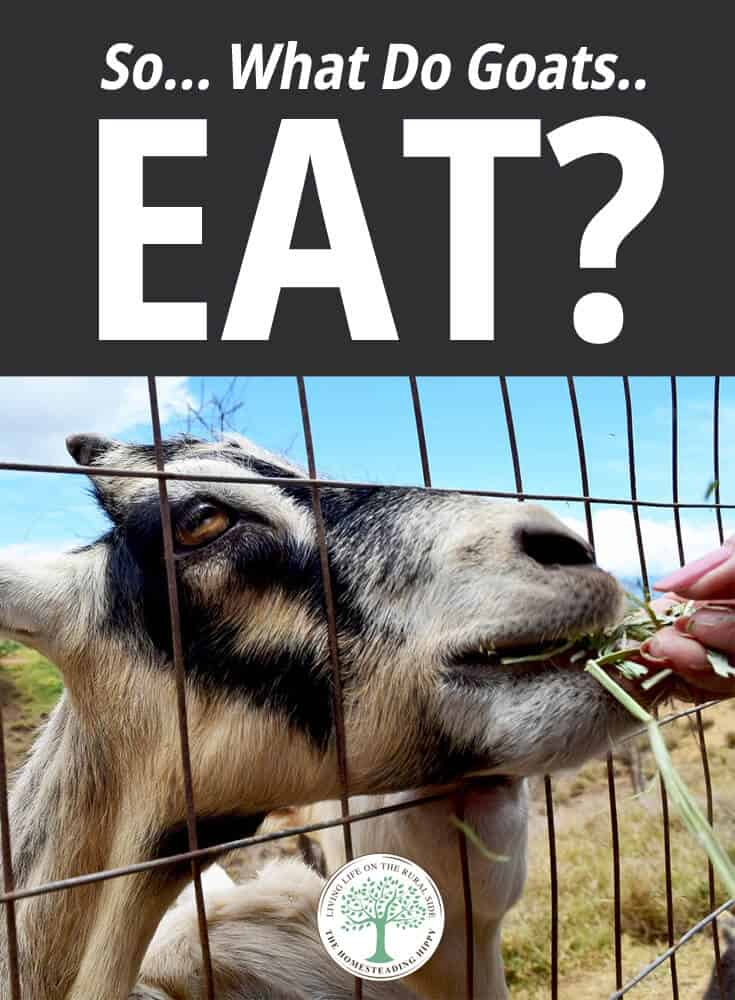

Amanda is a homesteader and a Jesus-loving, mother of 6 toddlers. She’s raising lots of fancy chickens and goats on her small homestead (among other things). Find out more about the team here.
